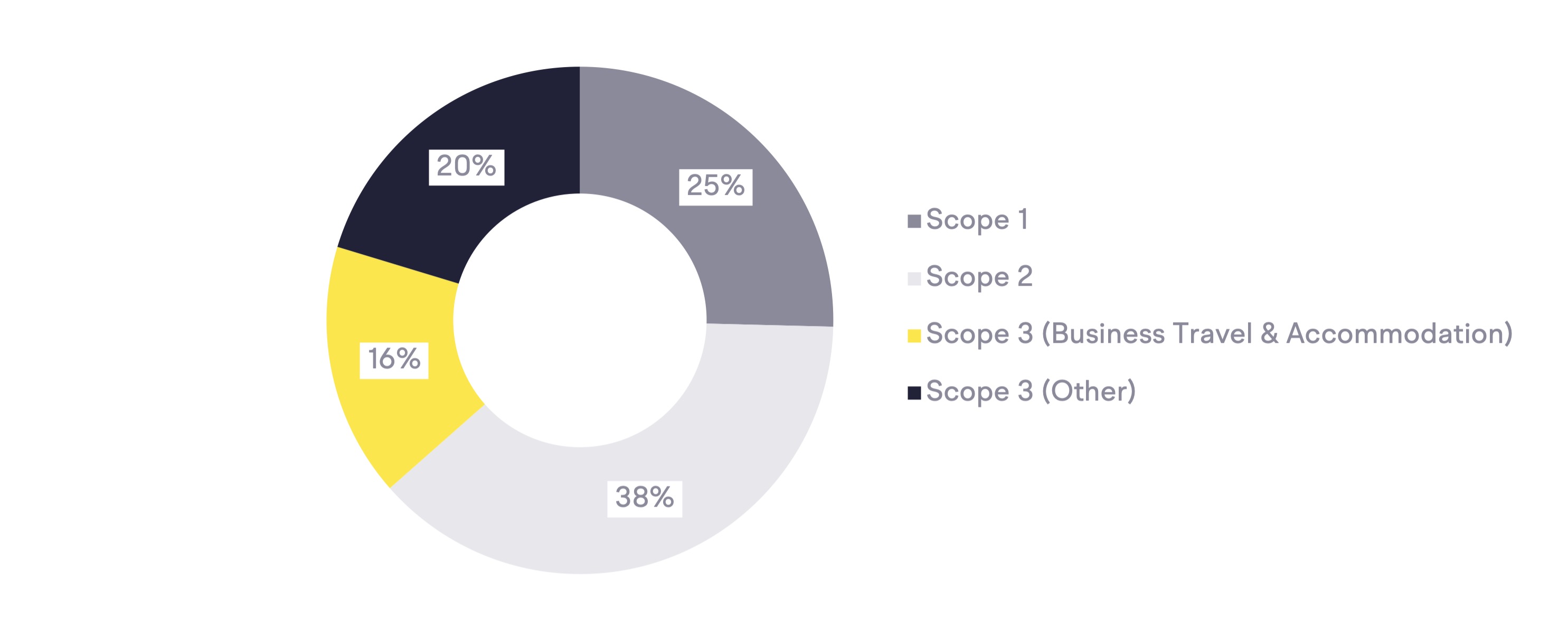Media Production - the impact of business travel on your carbon footprint

Do you work in the Media Production industry? As an industry that thrives on creativity and innovation, embracing sustainability is crucial for your company's future success. With the growing global concern for climate change, consumers and investors are more inclined towards businesses with robust environmental practices. Companies that establish and meet science-based net-zero targets can stand out in the market, attracting eco-conscious clients and investors. In this blog, we'll explore the carbon footprint of the media production industry and discuss effective strategies to reduce it, helping you stay ahead of the curve in sustainability.
On average, 16% of your carbon footprint will be from business travel
The carbon footprint of a company in the media production industry is primarily composed of scope 1 direct emissions, energy consumption, business travel and employee commuting.
Carbon Footprint of an Example SME in the Media Production Industry

Note – this is an SME who does not travel internationally, i.e. minimal international flights. If you travel internationally, this will significantly increase the carbon footprint of your business travel.
How to reduce your carbon footprint from energy consumption, business travel and employee commuting
Minimise your energy use (scope 2)
Scope 2 emissions are indirect emissions. They come from the electricity, heat, or cooling that your company buys from outside providers. These emissions occur at the power plants that generate the energy but are related to your company’s consumption.
- Improve energy efficiency with LED lighting, smart thermostats, and efficient appliances.
- Enhance building design and insulation to reduce heating and cooling demand (we would recommend looking at the UK Green Building Council as a source of useful information).
- Switch to renewable energy sources, such as solar, wind, or hydroelectric power.
- Upgrade and maintain efficient HVAC (heating, ventilation and air-conditioning) systems.
- Foster employee awareness and engagement in energy-saving practices (we love the work our friends at Clever Carbon do on how to engage employees in sustainable practices).
- Implement energy management systems to track and optimise energy usage (take a look at the work Metrikus do!).
- Promote virtual meetings and remote work to save energy.
- Practice green procurement by selecting sustainable suppliers and partners.
Make responsible choices in business travel
- Have virtual meetings where possible
- Encourage use of public transport and carpooling (Route Zero is a great tool to compare the carbon footprint of journeys)
- Direct flights: if air travel is necessary, choose direct flights to minimise layovers and reduce the overall carbon emissions associated with take-off and landing.
- Efficient trip planning: consolidate trips and plan efficient itineraries to minimise the amount of travel needed.
- Green vehicle rentals: if renting a vehicle is necessary, choose fuel-efficient, hybrid, or electric vehicles (we’re planning to try Green Motion for our next trip).
- Sustainable travel policies: develop and implement company-wide sustainable travel policies to guide employees in making eco-friendly choices and promote a culture of sustainability.
- Book eco-friendly accommodation: book environmentally conscious hotels or shared accommodation, like Airbnbs, that have lower emissions. To help you book environmentally conscious hotels, Staze is a platform that helps companies make net zero hotel bookings. Using Staze you can compare the carbon emissions of different hotels, just as you would compare their prices. Every booking made through Staze is offset for free, which means the platform invests in carbon reduction projects to counterbalance the emissions generated by your stay. Companies using Staze have reduced their emissions from hotel bookings by up to 70%.
Minimise employee commuting
- Encourage remote work and flexible schedules to minimise commuting.
- Offer incentives or subsidies for employees to use public transport, which generally has lower emissions per passenger than personal vehicles.
- Establish programs to help employees coordinate carpooling, reducing the number of individual vehicle trips. *Provide facilities for cycling or walking: offer secure bike storage, showers, or locker facilities to encourage employees to commute via bike or food.
- Offer incentives for employees to use electric or hybrid vehicles.
- Provide resources and information on eco-friendly commuting options (we love the work our friends at Clever Carbon do on how to engage employees in sustainable practices).
Your next steps
To show your company is serious about sustainability and not simply using it as a buzzword, we recommend starting by measuring your carbon footprint (we used our friends at Zellar) and setting a science-based net zero target. By making conscious choices in business travel, energy consumption and waste management by using platforms like Staze, you can significantly lower your environmental impact while still achieving your business objectives.

